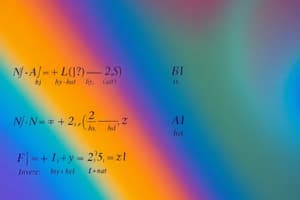Podcast
Questions and Answers
The Pythagorean Identity states that $\sin^2 \theta + \cos^2 \theta = 0$.
The Pythagorean Identity states that $\sin^2 \theta + \cos^2 \theta = 0$.
False (B)
In reciprocal identities, $\frac{1}{\sin \theta} = \cos \theta$.
In reciprocal identities, $\frac{1}{\sin \theta} = \cos \theta$.
True (A)
The Double-Angle Formula $\sin 2 \theta = \sin^2 \theta + \cos^2 \theta$.
The Double-Angle Formula $\sin 2 \theta = \sin^2 \theta + \cos^2 \theta$.
False (B)
Quadratic Trigonometric Equations involve the variable appearing to the first power.
Quadratic Trigonometric Equations involve the variable appearing to the first power.
Algebraic manipulation, substitution, and inverse functions like arcsin, arccos, or arctan are used to solve Trigonometric Equations.
Algebraic manipulation, substitution, and inverse functions like arcsin, arccos, or arctan are used to solve Trigonometric Equations.
Study Notes
Trigonometry - An Introduction to Angle Relationships
Trigonometry is a branch of mathematics that deals with relationships between angles, lengths of sides opposite those angles, and other quantities in triangles. At its core, it's all about understanding triangle shapes and how angles relate to each other within them. This field has been around for thousands of years, first appearing in Babylonian texts from around 2000 BC. Today, we use it in everything from navigation to building structures and designing electronics.
The three main functions you might encounter when learning trigonometry are sine, cosine, and tangent. These functions describe the ratio between two sides of a right triangle and the angle they share. To remember what these ratios represent, you can think of the first letter of their names: Sine = Side, Cosine = Curve, and Tangent = Tangent.
The Sine, Cosine, and Tangent Functions
Sine Function: The sine function (sin) is defined as the ratio of the opposite side to the hypotenuse in a right triangle. It tells you how long that side is compared to the whole triangle.
Cosine Function: The cosine function (cos) is the ratio of the adjacent side to the hypotenuse in a right triangle. It shows how long that side is compared to the whole triangle.
Tangent Function: The tangent function (tan) is the ratio of the opposite side to the adjacent side in a right triangle. It tells you how long the opposite side is compared to the adjacent side.
Trigonometric Identities
Trigonometric identities are equations that describe relationships between different trigonometric functions. They're useful for solving problems and simplifying expressions. Some common identities include:
- Pythagorean Identity: (\sin^2 \theta + \cos^2 \theta = 1)
- Reciprocal Identities: (\frac{1}{\sin \theta} = \cos \theta) and (\frac{1}{\cos \theta} = \sin \theta)
- Double-Angle Formulas: (\sin 2 \theta = 2 \sin \theta \cos \theta) and (\cos 2 \theta = \cos^2 \theta - \sin^2 \theta)
Trigonometric Equations
Trigonometric equations are equations that involve trigonometric functions. They can be either linear or quadratic. Some common types include:
- Linear Trigonometric Equations: These are equations where the variable appears only to the first power.
- Quadratic Trigonometric Equations: These are equations where the variable appears to the second power.
Solving such equations often involves using algebraic manipulation, substitution, and inverse functions like arcsin, arccos, or arctan.
In conclusion, trigonometry is a fundamental tool used by engineers, architects, scientists, astronomers, navigators, musicians, and many others. From measuring distances to designing bridges and buildings, this math discipline plays a vital role in shaping our world. As you delve deeper into trigonometry, you'll discover more about these three basic functions and their applications in solving various problems related to triangles and their properties.
Studying That Suits You
Use AI to generate personalized quizzes and flashcards to suit your learning preferences.
Description
Explore the basics of trigonometry, including sine, cosine, and tangent functions, common trigonometric identities like Pythagorean and double-angle formulas, and types of trigonometric equations such as linear and quadratic. Understand how trigonometry is applied in fields like engineering, architecture, science, and music.




